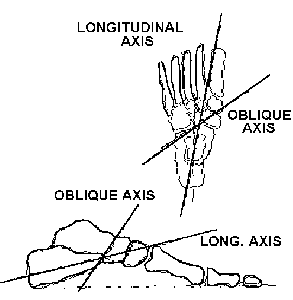MIDTARSAL JOINT
(TRANSVERSE TARSAL OR CHOPART JOINT)
has an oblique and a longitudinal axis
These axes do not necessarily correspond to talo-navicular
or calcaneo-cuboid articulations.
Moreover, the joint is functionally uniaxial, not biaxial. The joint only pronates or supinates.
| 
|
|---|
SUBTALAR/MIDTARSAL INTERACTION:
- Subtalar pronation causes the MTJ axes to become more parallel.
- Subtalar supination causes the MTJ axes to become non-parallel

The diagram, redrawn from McPoil and Knecht (1985), is an anterior view of the proximal surface of midtarsal joint. The C denotes the calcaneus where it articulates with the cuboid, and the T denotes the talus where it articulates with the navicular.
Two anatomical axes are described for the MTJ, even though the joint is functionally uniaxial. The best mechanical analogy I've found is the automobile fan belt. The belt is flexible until you twist it, when it becomes more inflexible or rigid.
When the MTJ axes are parallel, the entire foot becomes mobile.
When the MTJ axes are non-parallel, the entire foot becomes more rigid.

| Normal movement and timing of movement in the subtalar joint are important, because subtalar position influences the MTJ alignment and the foot's relative flexibility or rigidity.
|
|---|
For example, someone whose subtalar joint pronates excessively during loading response (green tracing) does not experience normal subtalar supination during late stance. Consequently, the foot is relatively mobile just when it should be rigid to communicate plantar flexor muscle force into the ground for push-off and propulsion.
Reference:
McPoil, T.G., & Knecht, H.G. (1985). Biomechanics of the foot in walking: A function approach. Journal of Orthopaedic and Sports Physical Therapy, 7, 2:69-72.


